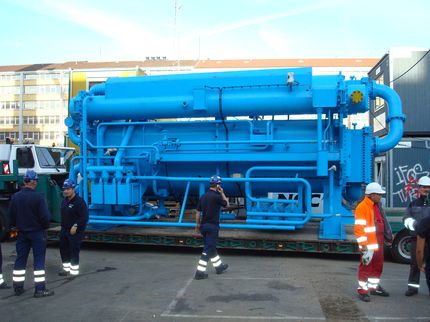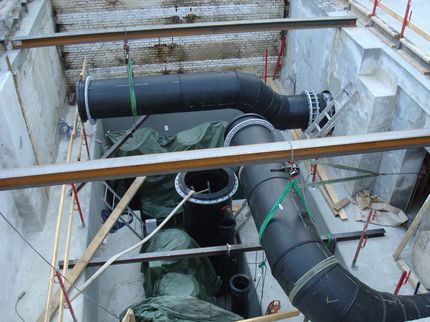District cooling of buildings using seawater or surplus heat, can prevent us from emitting large amounts of greenhouse gases into the atmosphere. The very first district cooling plant in Denmark is now ready to pump cold water into distribution pipes.
At the prospect of longer and warmer summers, the need for
cooling in buildings where people live, work, etc. will be greater
in future. This includes buildings such as shopping centres,
hotels, banks and offices, hospitals and nursing homes.
Today, many buildings of this kind have their own cooling systems.
A majority of these systems run on CFC gases which, like CO2,
contribute to global warming. Furthermore, they use large amounts
of electricity and water, especially the more inefficient systems.
They are also noisy and take up a lot and often rather expensive
space. These are obvious problems which may be solved by connecting
to a district cooling distribution system.
Legislation enables district cooling
Adoption by Folketinget (the Danish Parliament) of the District
Cooling Act in 2008, enabled Danish municipalities that fully or
partly own district heating companies to establish and run district
cooling systems. Copenhagen Energy, owned by the City of
Copenhagen, had been looking forward to this opportunity for
several years and was quick to take it. Today, the company has
established the first district cooling plant in Denmark, in the
buildings of a former power station in the heart of
Copenhagen.
The new cooling station will have a capacity of approximately 15MW
and is based on three different principles of cooling. This makes
it a very flexible and highly energy-efficient system. The district
cooling plant utilises seawater from the Port of Copenhagen in
periods where the seawater is sufficiently cold, as well as surplus
heat from power plants to produce environmentally-friendly cooling.
Finally, the plant also uses compressors running on
electricity.
 The photo shows the
absorber which will be converting surplus heat from power plants
into cooling production. The photo was taken just hours before the
absorber was craned into the cooling station in September 2009. The
absorber weighs about 40 tonnes and has an output of
3.4MW.
The photo shows the
absorber which will be converting surplus heat from power plants
into cooling production. The photo was taken just hours before the
absorber was craned into the cooling station in September 2009. The
absorber weighs about 40 tonnes and has an output of
3.4MW.
"The technology isn't really new. We are actually only taking a
known technology and applying it in a new and larger context. Of
course it requires a great deal of know-how to establish the
distribution system itself, but the municipalities in charge of the
distribution system already have the knowledge it takes to launch
similar projects," says Jan Don Høgh, head of the project at
Copenhagen Energy.
Cooling customers have already been landed
Before engaging in a district cooling project, there are
certain things to consider in project planning.
"Firstly, it's important to have a carefully thought through
system architecture, which includes finding a suitable site for the
plant, offering access to resources that would otherwise have been
wasted. Resources such as seawater and surplus heating," says Jan
Don Høgh.
"At the same time, the project must be feasible. District cooling
is market-driven and voluntary. An adequate supply of customers in
the vicinity of the plant, who can see good reasons for connecting
to the system, is also important, so that the plant's total cooling
capacity can be exploited," says Jan Don Høgh. According to Mr
Høgh, a nine-digit investment has been made in the district cooling
plant in central Copenhagen.
Mr Høgh is therefore pleased that many of the large local
enterprises on Kongens Nytorv who showed prior interest in the
project, have now decided to connect to the district cooling
system. These include the two Danish banks Danske Bank and Sydbank,
the Magasin department store, and the media group, Egmont. District
cooling is primarily offered to customers with existing cooling
systems of more than 150kW.
Significant benefits for climate and the
environment
District cooling works on the same principles as district heating.
The chilled water is produced centrally and carried to the end
customers through a system of pipes.
 The seawater wells
are connected to the seawater by two 800mm pipes. The total
capacity is approx. 2,500m3 an hour. The seawater is used for free
cooling and condenser systems.
The seawater wells
are connected to the seawater by two 800mm pipes. The total
capacity is approx. 2,500m3 an hour. The seawater is used for free
cooling and condenser systems.
The temperature supplied from the cooling station will be
around 6°C, and the return temperature is expected to be
12-16°C.
The benefits for climate and the environment are huge: According
to calculations by Copenhagen Energy, comparing district-cooling
with energy consumption and emissions figures for individual
cooling plants in the buildings on Kongens Nytorv, there is no less
than a 66% saving to be made in CO2 emissions annually. For SO2 and
NOx, the saving is 62% and 69% annually, respectively. Emissions of
CFC gasses can be reduced considerably as well. Emissions of 1kg of
CFC gasses correspond to around 1,400kg of CO2. As a rule of thumb,
there will be an average 10% CFC leak, which in the Kongens Nytorv
scenario would mean CFC emissions of 100kg annually, corresponding
to 140 tonnes of CO2.
More plants on the way
The district cooling plant to supply cooling for customers around
the Kongens Nytorv sqaure is the first of its kind in Copenhagen.
But more plants are underway. Copenhagen Energy has identified no
less than eight obvious district cooling areas in downtown
Copenhagen, and expects to develop the next project in the area
around the City Hall Square.